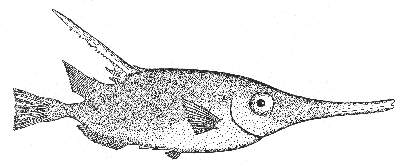Snipe fish Macrorhamphosus scolopax (Linnaeus) 1758
[Jordan and Evermann, 1896-1900, p. 759.]

Figure 158.—Snipe fish (Macrorhamphosus scolopax), off Nantucket.
Description—
The snipe fish is given so unusual an appearance by a long tubular snout with small toothless mouth at the tip, combined with a very long, stout dorsal fin spine that is saw-toothed along the rear edge that it could hardly be mistaken for any other Gulf of Maine fish.
Its body is about two-fifths as deep as long, measured from front of eye to base of caudal fin, so flattened sidewise that it is only about one-third to three-eighths as thick through as it is deep; the snout, measured from the front of the eye is about 11/3 times as long as the depth of the body. The eye is noticeably large. The two dorsal fins stand far behind the mid-length of the trunk. The first dorsal is of 5 to 7 spines and very short, the second, far the longer, is pointed, with about 11 to 13 soft rays; and the two dorsal fins are separated by an interspace nearly as long as the base of the first dorsal. The anal, with 19 to 20 rays, is much longer than the second dorsal, but lower; the caudal is square-tipped, of moderate size. The very small ventrals are located considerably behind the pectoral.
The snout, head, and sides are clothed with small rough scales. And the body is further stiffened with bony plates, of which there are 2 longitudinal rows of 4 each, high up on each side behind the gill opening; also 3 longitudinal series of 6 each along the lower breast and belly in front of the ventral fins, followed by 3 pairs behind the latter and finally by a single plate close in front of the anal fin, these last forming a sharp keel.
Color—
Pinkish or reddish on sides above, fading to silvery white below. Described as sometimes golden above.
Size—
Maximum reported size about 6¼ inches (16 cm.);[42] the few we have seen were about 4 inches long.
General range—
Widespread in warm seas. Eastern Atlantic, from the coast and Banks of Morocco, where it is sometimes taken in numbers, and the Mediterranean, northward to southern England (Cornwall, Devonshire); so far known in the western Atlantic only from the offing of Nantucket and from Massachusetts Bay.
Occurrence in the Gulf of Maine—
Oddly enough, the few records of this eastern Atlantic fish in our side of the Atlantic have all been within the limits of the Gulf of Maine; namely, one reported from Massachusetts Bay;[43] a second trawled south of Nantucket, at the 130-fathom contour line,[44] both many years ago; and eight specimens trawled in that same general vicinity (lat. 39°59' N., long. 69°47' W.) at 80 fathoms, by the Albatross III on May 14, 1950. Evidently it reaches the inner parts of the Gulf only as a stray, and at long intervals although it is taken from time to time by otter trawlers along the southwestern edge of Georges Bank in 75 to 85 fathoms.
[42] One of this size is pictured by Murray and Hjort (Depths of the Ocean, 1912, p. 397, fig. 268).
[43] Goode and Bean (Smithsonian Contrib. Knowl., vol. 30, 1895, p. 483), without further details.
[44] Original of Goode and Bean's illustration (Smithsonian Contrib. Knowl., vol. 31, 1895, pl. 127, fig. 396).